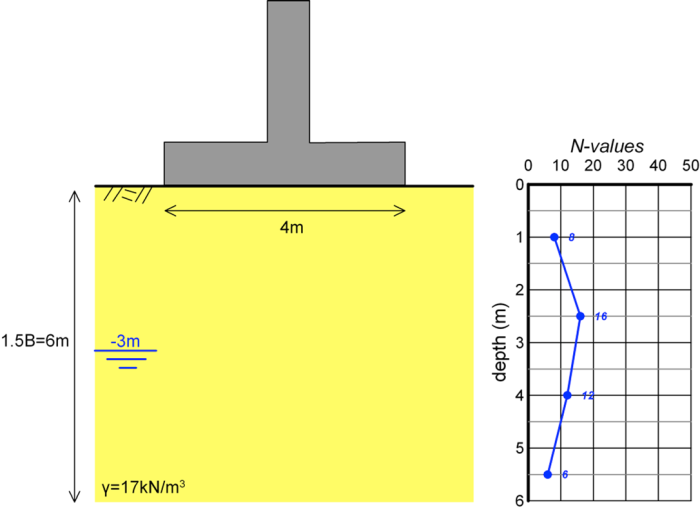Example 5.6
Design capacity from in situ tests: SPT
Estimate the design capacity of the footing shown below according to AS 5100.3, using directly the SPT measurements in the loose-to-medium sandy foundation soil.

Answer:
Before applying Eq. 5.53 to estimate the bearing capacity, we must first find the corrected N′ values for overburden stress, and the average corrected value N′ over a depth 1.5B = 6 m. Application of Eqs. 5.51 and 5.52 for calculating the overburden stress correction factor CN and accordingly the average N′ value for 6 m is presented in the table below.
| Depth (m) | N | Total stress (kPa) | Pore pressure (kPa) | Effective stress (kPa) | CN | N′ = NCN |
|---|---|---|---|---|---|---|
| 1 | 8 | 17 | 0 | 17 | 2.373 2.0* | 16 |
| 2.5 | 16 | 42.5 | 0 | 42.5 | 1.501 | 24 |
| 4 | 12 | 68 | 10 | 58 | 1.285 | 15.4 |
| 5.5 | 6 | 93.5 | 25 | 68.5 | 1.182 | 7.1 |
| N’average | 15.62 | |||||
*Note: Use of CN values higher than 2.0 is not recommended
Substituting in Eq. 5.53 while taking the groundwater table factors Cw1, Cw2 from Table 5.7 yields:
![]()
As the bearing capacity is determined from SPT test results, the appropriate range of the geotechnical strength reduction factor φg from Table 5.1 is φg = 0.35 to 0.40. Selecting conservatively the lower bound of the proposed range, the design capacity is determined in terms of stress as:
![]()

